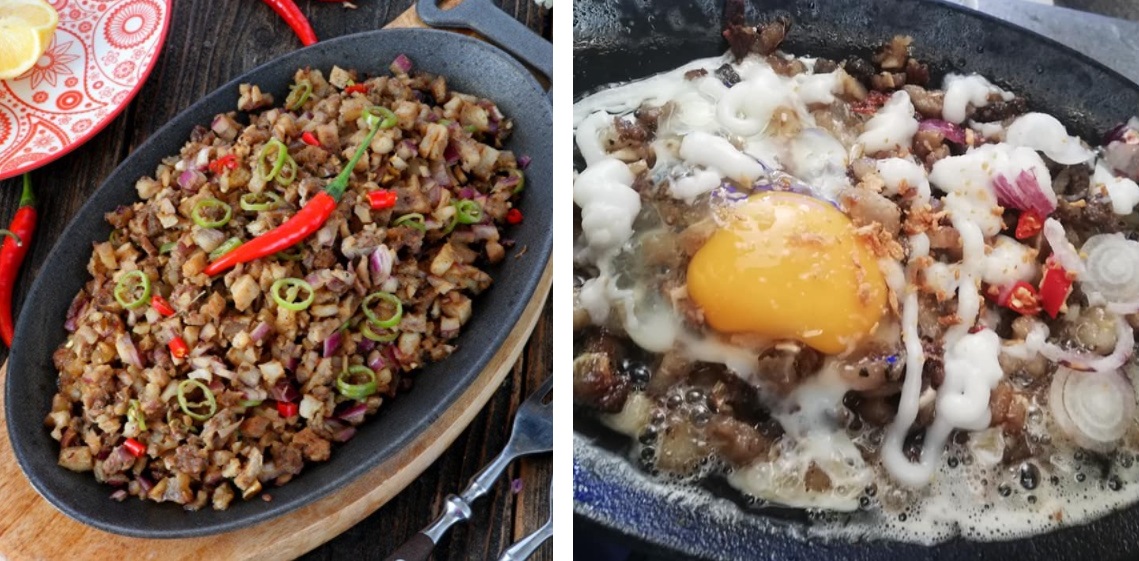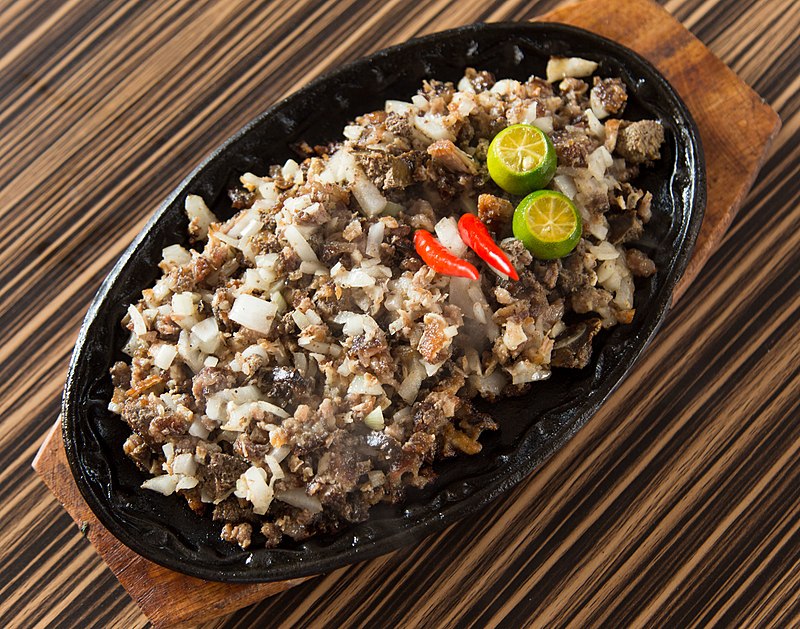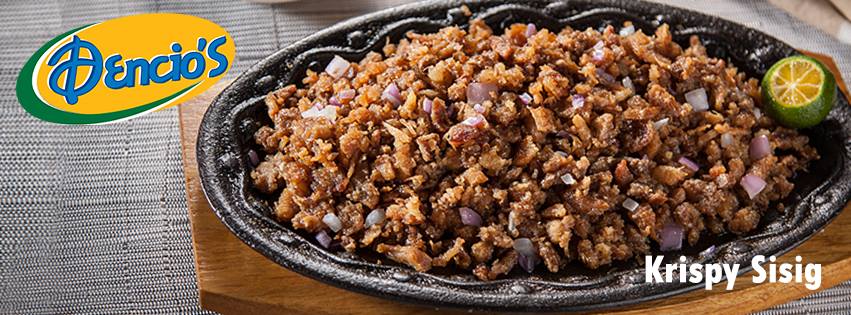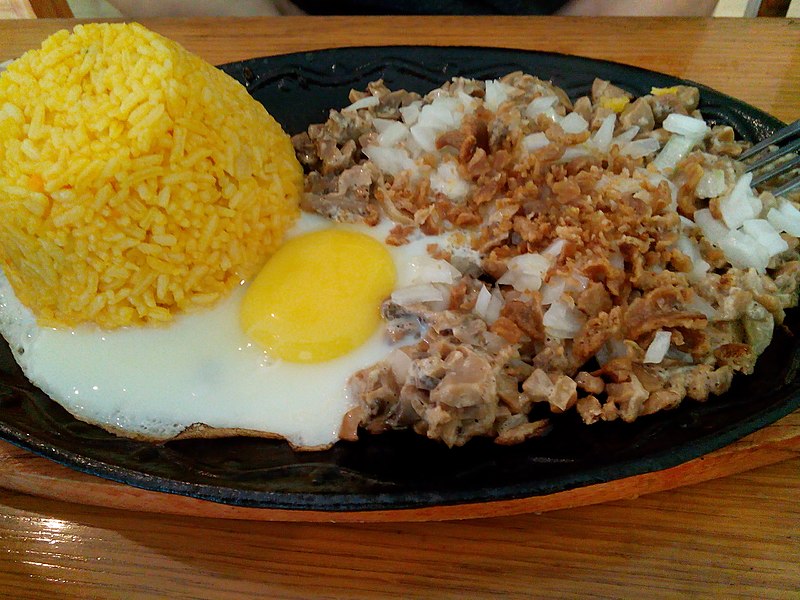Dear foreign readers, allow Tita S to tell you 14 facts about one of her favorite Filipino delicacies.
1.Sisig is a Filipino pork dish traditionally made from parts of a pig’s head (jowl, snout, and ears) and chicken liver, seasoned with Philippine lime (calamansi1), onions, and chili peppers.

Sisig (left) and Sisig with Egg (right) – Photo sources: https://www.facebook.com/SAF-tapsilog-105169524587479/photos/a.105178307919934/105178261253272 and https://www.facebook.com/SAF-tapsilog-105169524587479/photos/135094701594961
2. It originated from the province2 of Pampanga3, in the Luzon island group, in the northern part of the Philippine archipelago.
3. It is served hot as a main course or pulutan4, best served on a sizzling plate. As a main dish, it is enjoyed with steamed white rice; as a pulutan, it is enjoyed with cold beer or any alcohol beverage.
4. The earliest known record of Sisig can be traced to 1732, recorded by Augustinian friar Diego Vergaño in his Vocabulary of the Kapampangan5 Language in Spanish and Dictionary of the Spanish Language in Kapampangan. He defined Sisig as “a salad, including green papaya, or green guava, eaten with a dressing of salt, pepper, garlic and vinegar”.
5. Would you believe that Sisig was initially conceived as an austere cure for hangovers and nausea (and the vomiting that accompanied both)? The sourness of the dish was believed to suppress dizziness and the urge to vomit.
Sisig comes from an old Tagalog6 word sisigan which means “to make it sour”.
Sisig is also a term for a method of preparing fish and meat (usually pork), which is marinated in a sour liquid such as lemon juice or vinegar, then seasoned with salt, pepper and other spices.
6. You might wonder why the Kapampangans5 use pig’s head for this dish. Pig heads were not used in preparing meals for the U.S. Air Force in Clark Air Base, in Angeles City7, Pampanga3 during the American Occupation (1898-1946) and up to the 60s and 70s. They were given free or sold for a very low price.
7. Ricardo “Bapang Kadok” Dinio prepared this dish in his stall in Angeles City7.
Benedict Pamintuan of Sugay’s, a restaurant also located in Angeles City, used sizzling plates as serving vessels in the 1970s – 1980s to prevent the pork fat from speedily solidifying, and this was eventually adopted by other restaurants and households.
Dan Tayag, introduced Sisig in his restaurant in Manila called Trellis.
8. But it took Lucia “Aling Lucing” Cunanan, in a stall next to Dinio, to create the Sisig that we now know. Sometime during the mid-1970s, she first boiled the pig’s head to tenderize it and remove the hairs. It was then allowed to cool, then chopped and broiled or grilled till charred (according to one’s preference), especially the pig’s ears and cheeks. The mixture was finally seasoned with vinegar, calamansi juice, and coarsely chopped onions, and served in sizzling plates. Authentic Sisig Kapampangan5 has no egg or mayonnaise.

Authentic Kapangpangan Sisig – Photo source: Joy L. Cruz, own work, CC BY-SA 4.0, created 9 January 2019, https://en.wikipedia.org/wiki/Sisig#/media/File:Authentic_Kapampangan_Sisig.jpg
She then became known as Sisig Queen since they say that she reinvented the traditional Sisig and created the modern Sisig.
9. The Department of Tourism acknowledged that Aling Lucing’s restaurant established Angeles City7 as “The Sisig Capital of the Philippines” in 1974.
10. There are many variations of the Sisig recipe, from one family to another, from one city or town to another, in the province2 of Pampanga3 and other parts of the country, using other main ingredients like pork belly and/or shoulder, chicken, green mussels (tahong), tofu, squid, mixed seafood, canned tuna, and exotic ingredients like frog, ostrich, crocodile, and even python.

Bangus Sisig with Egg and Lechon Sisig by Zubuchon; Chicken Sisig, Squid Sisig by Manam (top-bottom, l-r) – Photo sources: https://www.facebook.com/zubuchonphilippines/photos/1650471258393037, https://www.facebook.com/zubuchonphilippines/photos/1586525738120923, https://www.facebook.com/SisigAndSizzlingSpecials/photos/112991967363102, and https://www.facebook.com/ManamPH/photos/a.1920631958220752/2805971659686773/

Manam’s Crispy Pork Sisig and Crispy Tofu Sisig (top-bottom) – Photo sources: https://www.facebook.com/ManamPH/photos/a.1920631958220752/2863148767302395 and https://www.facebook.com/ManamPH/photos/a.1920631958220752/2885505891733349/

Dencio’s Krispy Sisig – Photo source: https://www.facebook.com/denciosph/photos/a.10150913729770155/10152338429755155
The popular Sisig nowadays includes pork or chicken liver (or liver spread) and/or any of the following: raw eggs, ox or pig brains, crushed pork cracklings (chicharon), ginger, soy sauce, siling labuyo, and mayonnaise.
11. A variation of sisig in the city of Malolos, in the province2 of Bulacan, uses mushroom as the main ingredient, served with fried rice and egg.

Malolos-style Sisig served with fried rice and egg – Photo source: Bagoto, own work, CC BY-SA 4.-, created 19 July 2017, https://en.wikipedia.org/wiki/Sisig#/media/File:Mushroom_sisig.jpg
12. The annual Sisig Festival is held every December, in Angeles City7, in the province2 of Pampanga3, to celebrate the esteemed Sisig. It started in 2003 and was made an annual festival by Mayor Carmelo Lazatin to promote the city’s culinary heritage. Activities include a culinary contest among chefs using Sisig.
When Aling Lucing passed away in 2008, the festival was put on hiatus, and by 2014, Marquee Mall, in Angeles City7, incorporated the festival by including it within their annual Bite Bite! Northern Food Festival, held every October or November.
On April 29, 2017, the Angeles City Tourism Office organized a festival to celebrate Sisig, called “Sisig Fiesta”, a one-day event that featured a Sisig sampler banquet, Sisig and barbecue stalls, cooking demonstrations with celebrity chefs, and a showcase of Angeleño culinary talent through competitions.
13. In 2009, the late Anthony Bourdain. American celebrity chef, tasted Sisig in his television show “No Reservations”, bringing the dish mainstream.
In 2017, he told CNN that “Filipino food is about to become one of the trendiest cuisines in America … and sisig is perfectly positioned to win the hearts and minds of the world as a whole”.
14. Maharlika, a Filipino restaurant in New York (which closed in December 2019), added sisig to its menu in 2011 and was awarded the “Best New Food” by Time Out New York.
The information was obtained from https://pepper.ph/the-history-of-sisig/, https://www.foodandwine.com/news/sisig-filipino-food-anthony-bourdain-says-will-win-your-heart, https://www.unileverfoodsolutions.com.ph/chef-inspiration/certified-sisig-masters/the-history-of-sisig-shows-it-is-not-just-about-pork.html and the Wikipedia page “Sisig”6.
Cover picture collage (top-bottom): Pork Sisig by Trellis and Chicken Sisig with Egg by Kuya J – Photo sources: https://www.facebook.com/Trellis-Restaurant-94124441062/photos/10158390933826063 and https://www.facebook.com/KuyaJResto/photos/a.368095790017752/1877208825773100/.
Now, Tita S will briefly comment about Sisig.
This dish is a personal favorite, especially when it is not dry, but a bit creamy and spicy. Pork or tofu are top picks. I enjoy Sisig the most when it is served sizzling and a raw egg cracked over the mixture while it is still hot, then mixed with the rest of the ingredients before digging in.
Each spoonful combines the pork or tofu, which is crispy on the edges and soft at the center, with: the texture of the cartilaginous pork ears; fatty, juicy and/or savory taste of the chopped pork/brains and crushed pork cracklings (if used); the sweetness and texture of the coarsely chopped onions; the citrusy and tangy calamansi1 juice and vinegar; the spiciness of the siling labuyo9; and just the right amount of creaminess of the mayonnaise.
This is not a sponsored post. I just want my readers to know more about Philippine delicacies.
Did you find this post informative? I would like to hear your comment/s regarding Sisig.
See other interesting posts in this category (Pinoy Delights) and other categories – SCapades and Smart Travelers – Foreign Travelers Ask, Now You Know, and Say, Say, Say. Happy reading, and I hope that you will appreciate what I shared and some of the featured destinations will be part of your future travel plans!
Remember to share this post with your Facebook friends, and follow me by clicking on the bottom right corner of your device. And, do not forget to like this post. Thank you.
– – – – – – – – – – – – – – – – – – – – – – – – – –
The following terms are defined for interested readers, especially those with “Senior-Moments”, those not familiar with Filipino terms, and those too busy or lazy to Google such terms:
1Calamansi is a small (about 30-mm in diameter), tangy-sour citrus fruit with a thin, green skin (which turns yellow-orange when ripe), with a yellow/orange pulp. The juice is used in various food and beverages as a major/minor ingredient, seasoning or dipping sauce ingredient.
2A province is the primary administrative and political division in the Philippines. It is the second-level administrative sub-division of a region10. There are 81 provinces (called lalawigan) in the Philippines. Each province is governed by an elected legislature called the Sangguniang Panlalawigan and by an elected governor. The information was obtained from the Wikipedia page “Provinces of the Philippines.”11
See a related post: Foreign Seniors Ask: WHAT ARE PROVINCES IN THE PHILIPPINES?
3Pampanga is a province2 lying on the northern shore of Manila Bay, in the Central Luzon12 region10 (Region III) of the Philippines. It is bordered by the provinces of Tarlac to the north, Zambales to the west, Bataan to the southwest, Nueva Ecija to the northeast, Bulacan to the east, and Manila Bay to the central south. Its capital is the City of San Fernando. The information was obtained from the Wikipedia page “Pampanga”.13
This province is known as the Culinary Capital of the Philippines because of its delicious cuisine that features dishes like: sisig, tocino, nasing biringyi (chicken saffron rice), morcon, menudo, caldereta, estofado, embotido, asado, lengua, lechon, chicharon, afritada, bringhi (paella). The information was obtained from the Wikipedia page “Kapampangan cuisine”.14
4Pulutan is the Filipino term for an appetizer taken with alcoholic beverages.
5Kapampangan is an adjective which refers to:
* the ethnolinguistic group of people in the Philippines who live mainly in the provinces2 of Pampanga3, Bataan and Tarlac, as well as Bulacan, Nueva Ecija, and Zambales.
* the Austronesian language spoken by the Kapampangan people in the entire province of Pampanga and southern Tarlac, northeastern Bataan, and the municipalities15 of Bulacan, Nueva Ecija, and Zambales that border Pampanga.
* the cuisine of the Kapampangan people, especially in the province of Pampanga, dubbed as “The Culinary Capital of the Philippines”. Examples of dishes which are prepared nationwide are sisig, kare-kare16, tocino17 and longganisa18.
The information was obtained from the Wikipedia pages “Kapampangan people”19, “Kapampangan language”20 and “Kapampangan cuisine”14.
6Tagalog is an adjective which refers to:
* the second largest ethnolinguistic group of people in the Philippines (after the Visayan people), numbering around 30 million, with most of them inhabiting Metro Manila, the Calabarzon region in southern Luzon, the islands of Marinduque and Mindoro in the Mimaroparegion, as well as a plurality in the provinces2 of Aurora, Bataan, Bulacan, Nueva Ecija, and Zambales in Central Luzon12.
* the Austronesian language spoken by the ethnic Tagalog people. Its standard form is officially called Filipino, the national language of the Philippines.
The information was obtained from Wikipedia pages “Tagalog (people)”21 and “Tagalog language”22.
7Angeles City is a first class23 highly urbanized24 city in the Central Luzon12 region10 of the Philippines. While this city is geographically grouped with the province2 of Pampanga3 for statistical purposes, it is politically independent from that province, but nonetheless the province’s commercial and financial hub.
It is bordered by the city Mabalacat to the north, the municipalities15 of Porac to the west and southwest and Mexico to the east, the city of San Fernando to the southeast, and the municipality of Bacolor to the south.
It is served by the Clark International Airport in Clark Freeport Zone, the former Clark Air Base of the US Air Force which was converted into an international airport.
Angeles City is the hub for business, industry, aviation, education, and tourism in the Philippines, and a leisure, fitness, entertainment and gaming center of the Central Luzon region.
The information was obtained from the Wikipedia page “Angeles City”25 and “Clark Freeport and Special Economic Zone”26.
8Post https://en.wikipedia.org/wiki/Sisig post
9Siling labuyo, or simply labuyo, is a small chili pepper that developed in the Philippines after the Columbian Exchange27. It belongs to the species Capsicum frutescens and is characterized by triangular, very pungent fruits which grow pointing upwards. Siling labuyo is a Tagalog term meaning “wild chili”. The information was obtained from Wikipedia page “Siling labuyo.”28
10A region is an administrative division based on geographical, cultural and ethnological characteristics. Each region is further subdivided in provinces2, composed of cities and towns (called municipalities15), which in turn, are divided into barangays29, formerly called barrios, according to Wikipedia page “Regions of the Philippines” 30.
See a related post: Foreign Seniors Ask: WHAT ARE THE REGIONS OF THE PHILIPPINES?
11“Provinces of the Philippines,” accessed August 2, 2018, https://en.wikipedia.org/wiki/Provinces_of_the_Philippines
12Region III, called the Central Luzon Region, is a region10 located in the island group of Luzon in the northern part of the Philippine archipelago, with 7 provinces2: Aurora, Bataan, Bulacan, Nueva Ecija, Pampanga3, Tarlac and Zambales. It has three cities, all located in the province of Pampanga: Angeles7 (a 1st class23 highly urbanized city24), Mabalacat (a 3rd class31 component city32) and San Fernando (a 1st class component city and the regional center). It is dubbed as “The Rice Granary of the Philippines” because this region contains the largest plain in the country and produces most of the country’s rice supply. The information was obtained from the Wikipedia page “Central Luzon”.33
13“Pampanga” accessed April 2, 2018, https://en.wikipedia.org/wiki/Pampanga post
14“Kapampangan cuisine” accessed April 2, 2018, https://en.wikipedia.org/wiki/Kapampangan_cuisine post
15A municipality is a small, single urban administrative division, or local government unit (LGU)34, in the Philippines which has corporate status and powers of self-government or jurisdiction as granted by law. It is a unit under a province2, subdivided into barangays29, and is called town, or bayan. In the Philippines, a municipality is headed by a mayor, a vice mayor and members of the Sangguniang Bayan (legislative branch). The information was obtained from Wikipedia page “Municipalities of the Philippines.”35
16Kare-kare is a Philippine stew with a thick and savory peanut sauce, served hot as a main dish for lunch or dinner, with fish sauce (patis) as dipping sauce, or accompanied by sautéed fermented shrimp paste (bagoong alamang) on the side.
It is made from a base of oxtail (the traditional choice, with the skin on, cut into 2-inch lengths), beef tripe, pork hocks, calves feet, pig’s feet or trotters, various cuts of pork, beef stew meat, and ox tripe or offal, which is boiled till tender and cut into desired sizes. It can also be made with seafood (prawns/shrimps, crab, squid and mussels), goat meat, chicken, or purely vegetables like eggplant (talong), greens (e.g., Tagalog pechay, bok choy), young banana flower bud or “heart” (puso ng saging), okra, winged beans (sigarilyas), and green beans (sitaw).
The information was obtained from Wikipedia page “Kare-kare.”36
17Tocino is a Filipino-style, fried cured meat, often sweet, and is usually made of pork, but chicken and beef can also be used. Traditionally colored red using saltpeter, it is usually served for breakfast along with fried rice and fried egg, locally called tosilog.
See a related post: SILOG: THE FILIPINO WAY TO START A DAY
18Longganisa, or longaniza, in the Philippines, is a fresh or smoked sausage, made using varying ratios of lean meat (pork, beef, chicken, tuna) and fat, flavored with garlic, black pepper, salt, saltpeter, brown sugar and vinegar, and usually stuffed into a casing and formed into links. It can also be made without casing (skinless). Other ingredients may be added like anise liqueur, chili, paprika, and other spices. It is commonly dyed red, yellow, or orange, using achuete seeds. There are many regional variations of longganisa – dry, garlicky, spicy, or sweet. The information was obtained from the Wikipedia page “Longaniza”.37
19“Kapampangan people,” accessed February 28, 2021, https://en.wikipedia.org/wiki/Kapampangan_people post
20“Kapampangan language,” accessed February 28, 2021, https://en.wikipedia.org/wiki/Kapampangan_language post
21“Tagalog (people),” accessed February 28, 2021, https://en.wikipedia.org/wiki/Tagalog_(people) post
22“Tagalog language,” accessed February 28, 2021, https://en.wikipedia.org/wiki/Tagalog_language post
23A first class city in the Philippines has an average annual income for a 4-year period of at least 500 million pesos, according to the Wikipedia page “List of cities of the Philippines.”38
24A highly urbanized city is a city with a minimum population of 200,000 inhabitants, as certified by the Philippine Statistics Authority, and with the latest annual income of at least PHP50 million (USD1 million), as certified by the City Treasurer, according to the Wikipedia page “List of cities of the Philippines.”38
25“Angeles City,” accessed February 28, 2021, https://en.wikipedia.org/wiki/Angeles_City post
26“Clack Freeport and Special Economic Zone,” accessed February 28, 2021, https://en.wikipedia.org/wiki/Clark_Freeport_and_Special_Economic_Zone post
27The Columbian Exchange, or the Columbian Interchange, was the widespread transfer of plants, animals, culture, (free and enslaved) human populations, technology, diseases, and ideas between the Americas and the Old World in the 15th and 16th centuries. It is named after Christopher Columbus, and is related to European colonization and trade following his 1492 voyage. This term was first used in 1972 by the American historian Alfred W. Crosby in his environmental history book “The Columbian Exchange”. It was rapidly adopted by other historians and journalists. The information was obtained from Wikipedia page “Columbian Exchange”.39
28“Siling labuyo,” accessed July 18, 2018, https://en.wikipedia.org/wiki/Siling_labuyo post
29A barangay is the smallest administrative division in the Philippines, headed by a barangay captain, aided by a Sangguniang Barangay (Barangay Council). It is the native Filipino term for a district or village. It was formerly called a barrio. In a metropolitan area, a barangay is an inner city neighborhood, a suburb, or a suburban neighborhood. The word barangay originated from the term balangay, a kind of boat used by a group of Austronesian people who migrated to the Philippines. A number of barangays grouped together is called a district. All these were obtained from Wikipedia page “Barangay.”40
30“Regions of the Philippines,” accessed August 2, 2018, https://en.wikipedia.org/wiki/Regions_of_the_Philippines post
31A third class city in the Philippines has an average annual income for a 4-year period of 240 million, but less than 320 million pesos, according to the Wikipedia page “List of cities of the Philippines.”38.
32A component city is a type of city in the Philippines which does not meet the requirements of a highly urbanized city24. It is under the jurisdiction of a province2. If such a city is located along the boundaries of 2 or more provinces, it shall be considered part of the province of which it used to be a town (locally called a municipality). The information was obtained from Wikipedia page “List of cities of the Philippines.”38
33“Central Luzon,” accessed April 2, 2018, https://en.wikipedia.org/wiki/Central_Luzon
34A local government unit (LGU) in the Philippines is divided into 3 levels: provinces2, cities, municipalities15, and, barangays29, according to Wikipedia page “Local government in the Philippines”.41
35“Municipalities the Philippines,” accessed April 2, 2018, https://en.wikipedia.org/wiki/Local_government_in_the_Philippines
36“Kare-kare,” accessed December 12, 2018, https://en.wikipedia.org/wiki/Kare-kare
37“Longaniza,” accessed December 12, 2018, https://en.wikipedia.org/wiki/Longaniza
38“List of cities in the Philippines,” accessed April 2, 2018,
https://en.wikipedia.org/wiki/List_of_cities_in_the_Philippines
39“Columbian Exchange,” accessed July 18, 2018, https://en.wikipedia.org/wiki/Columbian_exchange
40“Barangay,” accessed April 2, 2018, https://en.wikipedia.org/wiki/Barangay post
41“Local government in the Philippines,” accessed April 2, 2018, https://en.wikipedia.org/wiki/Local_government_in_the_Philippines


One thought on “SAVORING SISIG, BURP!”